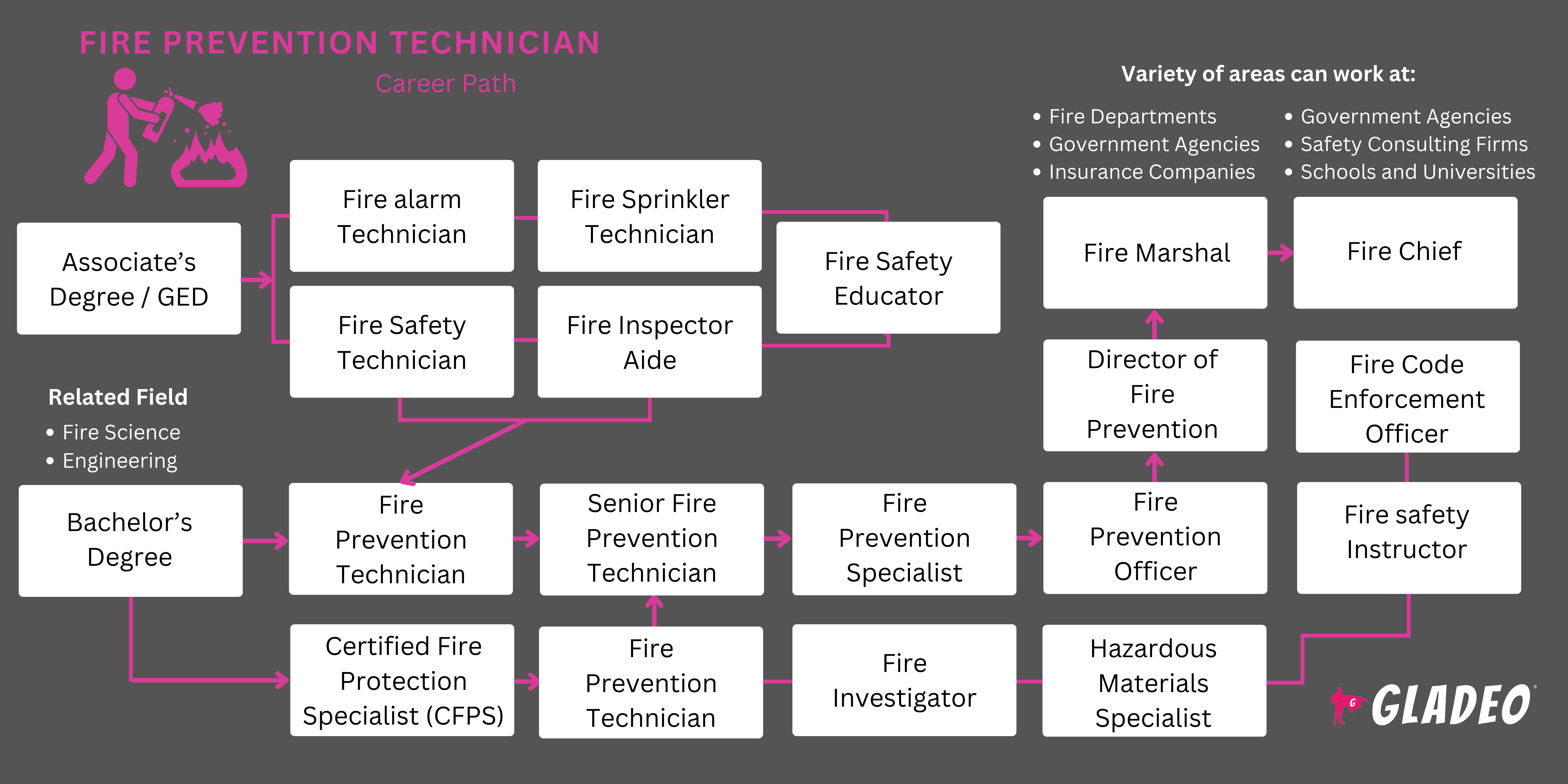스포트라이트
소방 검사관, 소방 안전 책임자, 소방청장, 소방 전문가, 화재 예방 코디네이터
인류가 불을 만들고 통제하는 방법을 알아내지 못했다면 우리는 여전히 석기 시대에 살고 있었을 것입니다. 난방과 요리를 위해 나무를 태우는 방법을 배우지 못했을 것입니다. 또한 석탄을 태워 전기를 생산하거나 불을 이용해 금속을 제련할 수도 없었을 것입니다.
하지만 불은 매우 유용하지만 지구상에서 가장 파괴적인 힘 중 하나이기도 합니다! 사람의 부주의, 과열된 기계, 전기 배선 결함 등으로 인해 의도하지 않은 화재가 발생하기란 매우 쉽습니다. 그렇기 때문에 많은 조직에서 이러한 잠재적 위험을 완화하기 위해 화재 예방 기술자를 활용합니다.
소방 검사관과 달리 기술자의 업무는 매우 실무적입니다. 일반적으로 화재 경보기, 스프링클러, 화재 안전 관련 전기 시스템 및 기계 부품의 설치, 유지보수, 수리 등 화재 예방 시스템의 기술적 측면에 중점을 둡니다.
산불 진화 대원과 함께 일하는 화재 예방 전문가도 있습니다.
- 화재로부터 인명과 재산을 안전하게 지키기 위한 지원
- 조직이 심각한 손실을 입지 않도록 잠재적으로 구할 수 있습니다.
- 다양한 프로젝트에 참여할 수 있는 기회
근무 일정
- 화재 예방 기술자는 일반적으로 풀타임으로 근무하며 잦은 출장과 초과 근무가 가능합니다.
일반적인 의무
- 기존 화재 예방 계획을 검토합니다. 규정 준수를 위한 화재 방지 시스템 평가
- 화재 방지 시스템 설계 및 설치 자문
화재 경보기, 스프링클러 및 기타 화재 진압 시스템 설치, 테스트 및 유지 관리 - 건물 및 작업 환경의 잠재적 화재 위험 식별
- 화재 안전 정책을 시행합니다. 경고 및 시정 통지 발행
- 개발자, 건축가, 엔지니어와 협력하여 조경과 식물이 가뭄에 강하거나 화재에 강한지 확인합니다.
- 건물의 화재 안전 점검 및 위험 평가 수행
- 건축 자재의 내화성 평가
- 필요에 따라 사진을 찍고 측정 장치 및 탄화수소 분석기를 사용합니다.
- 소화기 및 기타 소방 장비 점검
- 화재 감지 및 진압 시스템 성능 모니터링
- 인화성 물질의 보관 및 취급에 대해 문의하세요.
- 비상 대피 계획을 준비합니다. 거주자에게 화재 안전 수칙 교육
- 소방 훈련 및 시뮬레이션 구성
- 지역 소방서 및 응급 서비스와의 협력
- 화재 안전 문서 및 기록 업데이트
추가 책임
- 화재 허가 및 계획서 제출
- 화재 안전 회의, 워크샵 및 교육 프로그램 참여
- 화재 안전 규정 및 표준에 대한 대중의 문의에 응답하기
- 공공 소방 교육 세션 지원
- 화재 안전 문제와 관련하여 보험사와 연락하기
- 화재 사고의 원인을 파악하기 위한 조사 지원
- 화재 안전 강화를 위한 개선 사항 권장
- 화재 예방 및 방지를 위한 새로운 기술 및 방법 평가
소프트 스킬
- 분석
- 규정 준수 지향
- 비판적 사고
- 디테일 지향
- 독립
- 이니셔티브
- 무결성
- 관찰 기술
- 문제 해결 능력
- 안전 의식
- 건전한 판단
- 체력
- 시간 관리
기술 능력
- 대피/응급 상황 프로토콜을 포함한 비상 대응 계획
- 화재 경보기, 스프링클러 시스템 및 소화기에 대한 지식
- 건물 및 환경의 화재 위험 평가
- 화재 과학, 화재 행동 및 예방 조치에 대한 지식
- 위험 물질 취급 및 보관
- 화재 사고 조사
- 지역, 주 및 연방 건축 법규 및 표준 준수
- 생명 안전 코드
- 검사, 규정 준수 활동, 조사 등에 대한 보고서 작성 및 문서화
- 건축 계획, 전기 다이어그램, 소방 시스템 도식 이해하기
- 체력 단련
- 기본 응급 처치 및 심폐소생술 인증
- 건설 회사
- 교육 기관
- 소방서
- 정부 기관
- 의료 시설
- 접객업 및 엔터테인먼트 장소
- 산업 시설
- 보험 회사
- 민간 화재 안전 컨설팅 회사
- 부동산 및 자산 관리 회사
화재 예방 기술자는 건물과 주변 지역을 화재 위험으로부터 최대한 안전하게 보호해야 할 책임이 있습니다. 이 직업은 화재 안전 규정과 화재 방지 시스템에 대한 깊은 이해가 필요하며, 기술 발전과 규제 변화를 따라잡아야 합니다.
기술자는 검사를 수행하거나 긴급 상황에 대응하기 위해 야간 및 공휴일을 포함한 불규칙한 시간대에 근무할 수 있습니다. 육체적으로 힘들거나 어려운 환경을 탐색하고 무거운 장비를 다루어야 하는 업무일 수 있습니다. 사고 후 조사를 수행하기 위해 위험 지역에 들어갈 때는 개인적인 위험이 따를 수 있습니다.
마지막으로 치명적인 화재의 여파를 목격할 가능성이 항상 존재하기 때문에 스트레스를 받을 수 있습니다. 이러한 어려움에도 불구하고 소방 기술자는 전문적인 헌신과 개인적인 회복력을 통해 생명과 재산, 지역사회를 보호하는 데 자부심을 느낍니다!
화재를 더 잘 억제하고 거주자가 더 안전하게 대피할 수 있도록 건축 설계에 전략적 화재 예방 요소를 통합하는 추세가 증가하고 있습니다. 또한 내화 건축 자재의 사용도 증가하고 있습니다.
화재 예방을 위해 건물에서 화재가 어떻게 시작되고 확산될지 예측하기 위해 정교한 컴퓨터 모델과 시뮬레이션에 점점 더 의존하고 있습니다. 이러한 첨단 모델은 보다 효과적인 화재 안전 전략과 비상 대응 계획을 개발하는 데 도움이 됩니다.
한편, 사물인터넷 기기와 통합된 스마트 감지기 및 알람과 같은 스마트 기술은 잠재적인 화재 위험에 대한 실시간 모니터링, 조기 경보, 원격 진단을 제공하는 데 도움이 되고 있습니다. 이러한 향상된 기능은 연기나 화재의 징후가 감지되면 즉시 응급 서비스에 알림을 전송하여 생명과 재산을 보호할 수 있습니다.
젊은 시절, 소방 기술자들은 문제 해결과 계획이 필요한 실제적인 체험 활동을 즐겼을 것입니다. 안전 문제에 대해 예민하게 인식하고 항상 잠재적인 위험과 위험을 주시하고 있었을 것입니다.
- 화재 예방 기술자는 일반적으로 소방 과학, 공공 안전 또는 관련 분야의 준학사 학위가 필요합니다. 일부 기술자는 실제로 소방관으로 시작하기도 합니다.
- 소방관은 대학 학위가 필요하지 않지만 18세 이상, 고등학교 졸업장 또는 검정고시 학력이 있어야 하며 소방 아카데미 프로그램을 이수해야 합니다.
○ 소방관 응시자는 신원조회 및 면접과 일반시험, 후보자 신체능력검사 또는 BIDDLE 검사, 신체-심리검사를 통과해야 합니다.
소방 아카데미 프로그램은 12~14주 동안 진행되며 "소방, 화재 예방 기술, 현지 건축법, 응급 의료 절차" 등의 주제를 다룹니다.
○ 미국 소방청의 소방 및 응급 서비스 고등 교육 프로젝트에 따라, 학생들은 관련 커뮤니티 칼리지 또는 직업 훈련 과정을 수강하여 유리한 출발을 할 수 있습니다.
○ 일부 부서는 소방관 지원자에게 응급구조사 또는 구급대원 자격증을 요구합니다.
○ 채용된 소방관은 주 및 지역 기관에서 실시하는 지속적인 교육과 국립 소방 아카데미에서 실시하는 연방 교육 세션에 참석할 수 있습니다.
○ 산불진화대원 산림청 견습과정 이수
- 소방관의 길을 걷지 않는 화재 예방 기술자의 경우 관련 업무 경험이 필요합니다. 많은 교육 프로그램에서 인턴십이나 협동조합을 제공하여 실무 경험을 제공합니다.
- 학사 학위는 도움이 될 수 있지만 화재 예방의 공학적 측면에 집중하지 않는 한 필요하지 않습니다.
- 고용주는 신원 조회와 약물 및 알코올 검사를 요구할 수 있습니다.
- 화재 예방 기술자가 작업 현장으로 이동하려면 유효한 운전 면허증이 필요합니다.
- 기술 및 규정에 대한 최신 정보를 얻기 위해서는 지속적인 교육이 중요합니다.
- 준학사 학위 외에도 선택적 자격증을 통해 자격을 강화할 수 있습니다. 옵션에는 다음이 포함됩니다:
○ 시설 관리자를 위한 공인 화재 경보 ITM 전문가
○ 공인 소방 검사관 I 및 II
○ 공인 소방 전문가
○ 시설 관리자를 위한 공인 스프링클러 ITM 전문가
○ 공인 수계 소방 시스템 검사, 테스트 및 유지 보수
○ 공인 수계 시스템 전문가
- 소화 시스템, 경보 및 감지 시스템 및 구성 요소, 출구 경로, 화재 안전 코드, 의료 서비스 및 응급 처치, OSHA의 비상 표준 및 작업장 화재 안전에 사용되는 에이전트에 중점을 둔 미국 안전 전문가 협회의 화재 예방 전문가 13시간 온라인 과정입니다.
- 소방 기술자는 4년제 학위가 필요하지 않습니다. 많은 커뮤니티 칼리지에서 적합한 소방 과학 프로그램을 제공합니다.
- 어떤 학생들은 먼저 소방관이 되겠다고 지원하여 소방학교 프로그램에 진학하기도 합니다.
- 재정 지원과 장학금을 받을 수 있는지 고려하세요!
- 주 내 수업료와 타주 수업료 및 수수료에 유의하세요.
- 졸업생 취업률에 관한 프로그램 통계를 확인하세요.
- 졸업생을 채용하는 고용주와의 인맥이 있는지 확인하세요!
- 수학(대수 및 기하학 등), 화학, 과학 과목에 초점을 맞춰 화재 역학 및 예방 전략을 이해하기 위한 탄탄한 기초를 쌓을 수 있는 주제에 대해 학습합니다.
- 수학 능력은 다음과 같은 작업에 유용합니다:
○ 점유 제한 및 퇴거 요건을 결정하기 위한 공간 면적 계산
○ 화재 진압 시스템 및 경보에 대한 이해 - 기본적인 수력 계산 또는 경보 회로의 전기적 계산을 포함합니다.
○ 화재 사고 데이터의 통계 분석을 통해 패턴 또는 확률을 식별하는 위험 평가 수행
- 지역 소방서 또는 응급 서비스에서 자원봉사를 하며 직접 경험하기
- 화재 과학, 건축법 및 화재 예방 관행과 관련된 서적, 기사 및 동영상 튜토리얼을 학습하세요.
- 검사, 규정 집행 또는 화재 안전 교육과 같은 화재 예방의 특정 관심 분야를 결정하여 교육 경로를 맞춤화하세요.
- 이력서를 최신 상태로 유지하고 관련 경력, 자격증, 교육 성과를 추가하세요.
- 잠재적인 전문가 추천인에게 연락처 정보 제공에 대한 허락을 요청하세요.
- 숙련된 소방 기술자들과 네트워크를 형성하여 직업에 대한 통찰력을 얻으세요. 가능하다면 하루 동안 기술자의 직장을 섀도메이킹하여 어떤 일을 하는지 살펴보세요.
- 전국소방협회와 같은 전문 단체에 가입하여 동료들과 교류하고, 전문가로부터 배우고, 리소스에 액세스하세요.
- 운전면허증을 취득하고 깨끗한 운전 기록을 유지하세요.
- 잠재적인 신원 조회에 대비하세요

- 필요한 교육을 이수하고 소방 안전 견습직과 같은 관련 직책에서 먼저 업무 경험을 쌓으세요.
- 학교의 커리어 센터를 방문하여 이력서 작성 및 모의 면접에 대한 도움을 받으세요.
- 인디드, 글래스도어, 지피아, USAJOBS와 같은 취업 포털에 프로필 만들기
- 지원하고자 하는 직무를 담당하는 고용주의 웹사이트를 살펴보세요. 회사의 가치와 사명에 대해 알아보세요.
- 구인 광고를 주의 깊게 살펴보세요. 이력서에 사용할 수 있는 키워드를 기록해 두세요:
- 규정 준수
- 긴급 대응
- 화재 경보 시스템
- 화재 예방
- 화재 안전
- 화재 진압 시스템
- 위험 분석
- 인시던트 조사
- 검사
- NFPA 표준
- 위험 평가
- 안전 프로토콜
- 소방 기술자 이력서 템플릿을 검토하여 아이디어 서식 지정하기
- 현직 소방 기술자에게 연락하여 구직 팁을 요청하세요.
- 소방 기술자 면접 질문을 공부하여 어떤 질문을 받을 수 있는지 알아보세요.
- 면접에 적합한 복장을 갖추고 친구들과 함께 모의 면접을 연습하세요.
- 상사와 전문성 개발에 대해 이야기하세요!
- 모든 화재 예방 기술자가 학사 학위를 소지한 것은 아니지만 어느 시점에서는 도움이 될 수 있습니다.
- 때로는 추가 과정이나 자격증을 취득하면 연봉 인상이나 승진에 도움이 될 수 있습니다.
- 코드, 법률, 표준 또는 기타 지침의 관련 변경 사항에 대한 최신 정보 유지
- 관련 장비, 시스템 또는 소프트웨어에 대한 제조업체 및 소프트웨어 안내서 연구
- 노련한 전문가로부터 새로운 것을 계속 배우세요
- 감독 역할을 포함하여 더 많은 책임을 맡기 위해 자원하기
- 다른 사람들을 철저히 교육하고 그들이 따를 수 있도록 모범을 보이세요.
- 중소규모 조직에서는 승진의 기회가 제한적일 수 있습니다. 승진을 위해서는 언젠가는 더 큰 조직에 지원해야 할 수도 있습니다.
- 자신의 전문 분야에 해당하는 전문 조직 및 그룹에서 활동하세요.
웹사이트
- 자동 화재 경보 협회
- 미국 화재 스프링클러 협회
- 알코올, 담배, 총기 및 폭발물 국
- 공공 안전 우수성 센터
- 소방서 안전 책임자 협회
- FireScience.org
- 소방 기술자 협회
- 국제 방화 수사관 협회
- 국제 폭탄 기술자 및 수사관 협회
- 국제 소방서장 협회
- 국제 코드 위원회
- 전국 화재 조사관 협회
- 전국 소방관 협회
- 국립 소방 학교
- 전국 소방 협회
- 전국 화재 스프링클러 협회
- 소방 기술자 협회
- 미국 소방청
- 불 속의 여성
책
- 국제 소방 훈련 협회, 화재 검사 및 코드 시행
- 소방 검사관: 원칙과 실무, 존스 앤 바틀렛 러닝, 존스 앤 바틀렛 학습
- 화재 방지 시스템, A. Maurice Jones Jr.
- NFPA의 생명 안전 코드
- 화재 예방의 원리, 데이비드 디아만테스, A. 모리스 존스 주니어 저.
소방 기술자는 자신이 근무하는 조직의 중요한 구성원이지만, 다른 직업 옵션을 탐색하고 싶다면 아래 추천 직책을 확인해 보세요!
- 방화 수사관
- 건설 및 건축 검사관
- 응급 의료 기술자(EMT)
- 비상 계획
- 소방 장비 유지 보수 기술자
- 소방수
- 화재 검사관
- 소방 안전 엔지니어
- 법의학 기술자
- 위험 물질(HazMat) 전문가
- HVAC 기술자
- 경찰 또는 형사
- 배관공
- 사립 탐정
- 안전 규정 준수 책임자
- 태양광 발전 설치자
- 스프링클러 시스템 설치 관리자
뉴스 피드

주요 채용 정보

온라인 과정 및 도구







